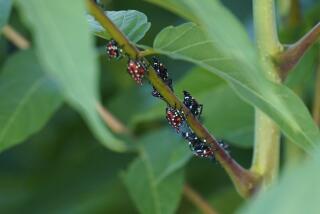Making a Crisis Out of an Anthill
- Share via
SAN DIEGO — Self-centered species that we are, Californians tend to look at ants and think only of the trouble they’re causing us: our kitchen, our picnics, our bird feeders.
But now two researchers at UC San Diego have found evidence that the annoyance to humans caused by the California invasion of Argentine ants may be small cheese compared to the damage being inflicted on other animals.
“The results could be disastrous to an entire ecosystem,” said researcher Andrew Suarez, a doctoral student in conservation biology.
The most seriously imperiled species could be the coastal horned lizard, possibly being pushed closer to extinction by waves of Argentine ants. Even before the insects arrived, the horned lizard was listed as a “species of special concern,” the first step toward becoming threatened, endangered and then kaput.
The Argentine ants (Linepithema humile) are firmly established from the San Francisco Bay Area to the rivers and streams near Sacramento and along the Southern California coast. In recent years, they have become public pest No. 1 in California, surpassing even those perennial disfavorites, fleas and roaches.
The clime of coastal California is particularly hospitable for the propagation of Argentine ants. Farther inland it is too hot and dry; farther north, too cold; but along the coast, that’s paradise for an ant.
Small but hardy, the insects are wiping out colonies of larger but less aggressive ants, which is bad news for animals that eat ants. The Argentine ants build huge colonies, with 20 to 100 super-breeding queens each, and intricate tunnels connecting colonies populated by millions of ants.
Two areas in coastal San Diego County--one near Miramar Naval Air Station, one near Torrey Pines State Park--that have been prime territory for horned lizards have become battlegrounds between the Argentine ants and the native harvester ants. It’s a mismatch.
“We can actually see them fighting,” said biology professor Ted Case. “When the Argentines move in, native ants disappear.”
When the Argentine ants appear, the horned lizards huddle together like pioneers circling their covered wagons. There is little strength in numbers, given the Argentine ant’s mobility, ferocity and knack for organization.
As a result, the horned lizard, which thrives on harvester ants, is finding its food source dwindling. The Argentine ants apparently taste lousy and, worse, have a hostile temperament and have been known to swarm a fleeing lizard.
“The Argentines are very aggressive toward the horned lizard,” Suarez said.
Suarez and Case have outfitted two dozen of the lizards with tiny 3-gram radio monitors so their movements can be monitored. Soundings are taken twice daily to gauge the lizards’ movements in relation to the Argentine ants.
*
The ruddy-faced horned lizard, which can grow to six inches in length, appears to be switching to beetles for dining. But it is unknown whether such a radical change in their diet will stunt the lizards’ growth or their ability to make little lizards.
So serious a threat has the Argentine ant become that it is now the subject of scholarly concern. Suarez presented his research this month to an Ecology Society of America convention in Albuquerque.
Ants are on the march across America and none so determinedly as the Argentine. First spotted in New Orleans a hundred years ago, the Argentine ant’s first California appearance was in Ontario, in western San Bernardino County, in 1905.
For agriculture, the Argentine ants are a double shot of bad news. They kill or displace the harvester ants, which are excellent seed spreaders. And they help spread dreaded aphids, which suck the life from plant stems and leaves.
At particular risk are crops such as tomatoes, citrus, honeydew and the avocado. The presence of the Argentine ants and aphids are forcing farmers to resort to the kind of strong pesticides that they have been trying to phase out.
“The ants make them [farmers] crazy,” said Eric Larson, executive director of the San Diego County Farm Bureau. “You can’t just stand back and let them proliferate. You’ve got to fight back.”
Suarez and Case and others hope to find a strategy to fight the Argentine ants without resorting to pesticides. The problem with pesticides, of course, is that they tend to kill good bugs and bad bugs alike.
*
“The natural pollinators [mostly bees and insects] that we depend on get nailed by pesticides too,” Suarez said. “We’ve got to find another way.”
A biologist at UC Berkeley is seeking permission from the U.S. Department of Agriculture to import a species of exotic fly from Brazil to test its ability to kill the Argentine ant. In the wild, the fly harasses the ant mercilessly, including laying its eggs on the ant’s backs.
With so many fuming at the Argentine ant, is there anything good about the tiny creature?
“Really, I can’t think of anything,” said Suarez, who is doing his doctoral thesis on the Argentine ant. “The best I can say is that at least they don’t sting. If they did, you’d really hear about them.”






